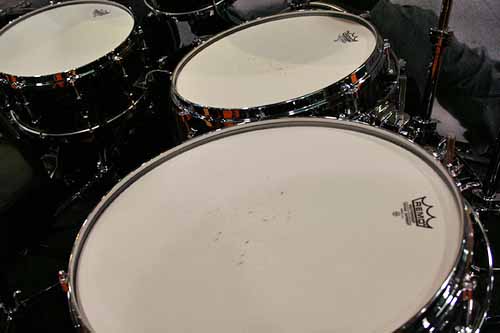When it comes to sets of heads for the toms on your kit, Remo and Evans are the clear leaders in the industry, and both of them offer a wide variety of different materials and construction. Generally speaking, you’ll want to use a 2-ply head on your toms; it’ll give you more of that deep, resonant tone these drums bring to your sound.
The main differences you’ll find between different styles of head are the material used in the construction and whether or not the head is coated. While each person’s own tastes are unique, the 4 heads listed below are all great choices and among the best drum heads for toms. Let’s take a look.
Remo Pinstripe
The pinstripe has long been a favorite choice for tom heads and is an especially popular choice among jazz drummers because of the overall warmth of the tone. It’s made of two 7-mil plies (see full specs) with a third layer between them along the outer edge that serves to dampen the high-frequency overtones, darkening the overall sound. Because the main striking surface is uncoated, you can still get a bright, sharp attack when the music calls for it, giving you a wider range of tonal options than most tom heads on the market.
https://www.youtube.com/YXNaRzYERmU
Evans Onyx
If you really want to beef up the low end of your tom sound, the Onyx heads made by Evans are designed to bring that extra depth to your tone. The construction uses two plies of 7.5-mils each, increasing the durability of the heads and giving you a punchy attack that cuts through the sound on stage.
The sleek matte black coating also increases the durability and gives the heads far more aesthetic appeal than most. The biggest benefit the coating brings to your tone is in the resonance, which is deep with a great sustain that sounds just as good in the studio as it does live. Hands down, these are among the best drum heads for toms.
https://www.youtube.com/goc2OYjxexo
Evans Hydraulic Glass
Another excellent and innovative option from Evans are their Hydraulic Glass heads. On the surface they look like any other uncoated 2-ply head, but what sets them apart is the oil filling between the two layers that acts as extra insulation to dampen some of the high treble overtones. This puts more emphasis on the lower overtones, giving your sound a fat funky depth without taking anything away from the initial attack. The feel of these heads is also different from others on the market, with a bit more bounce that makes playing them feel effortless.
Remo PP0940BA Ambassador Coated Drumhead
A lot of tom-specific heads are geared at bringing out the low end of your sound, but sometimes you want a sound that’s a bit brighter and sharper, especially for harder and faster styles. The classic coating on these Ambassador drumheads gives you a punchy, powerful attack with slightly less sustain than most of the heads on this list.
https://www.youtube.com/8H97hBDsATY
Remo’s known for the durability of their heads, and the Ambassadors are built to take quite the beating before they start to lose their tone. They’re also a great value for an entire tom set, making them perfect for every level of player. These are likely the best drum heads for toms if you’re on a budget.
Coatings and Dampers
The main way that a coating changes the sound of a drumhead is by adding more weight. The sound produced by your drums is the product of vibration. Altering the material that’s vibrating changes the wavelength of the sound; adding weight will make it deeper than an identical head that’s not coated, and it will sound warmer even when you tune it to the same pitch.
Aside from coating the head, manufacturers can alter the way it sounds by adding extra materials between or atop the plies of the head itself. Many popular heads have a ring of extra material around the outer edge that serves to muffle the sound slightly. This can keep you from getting the very high overtones of the sound, and can be a good solution if you feel other heads have a sound that’s too bright or strident.
Some manufacturers add materials that give the drum sound an extra effect, like the Evans Hydraulic Glass (see full specs), which gives your tone the “wet” sound popularized in the ‘70s. These kinds of extra sounds may not be suited for your everyday playing but can be fun things to have on hand to use when the time is right—an easy and affordable way to add more sounds to your toolbox.
The Best Drum Heads for Toms: Singles vs. Sets
The products listed here all come as a set, with a head to fit each of the tom sizes on a standard drum kit. If you want to update your sound by replacing all of your tom heads, this is a convenient way to get everything you need in one fell swoop. It can also often be more affordable than buying each head individually. Even if only one of your heads is worn out, you may want to buy an entire set of replacements, especially if you’re changing to a new brand or style, to maintain the consistency of your tone across your toms.
Having said that, you can also find these same heads sold as singles in the same array of sizes. Once you find the right heads for the tom on your kit, you won’t have to buy an entire set every time you need to replace them—especially helpful since most players find they use certain sizes of their toms more than others, and will subsequently need to replace those heads with more frequency. The option of buying your heads individually may also be helpful if you use a non-conventional arrangement of toms in your kit and either need more of or won’t be using certain sizes.








